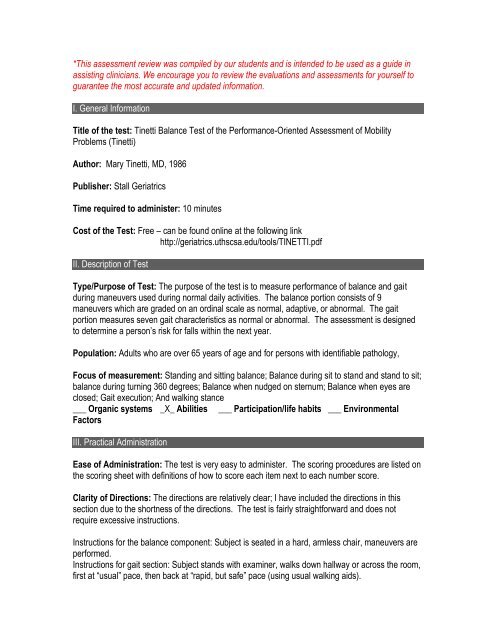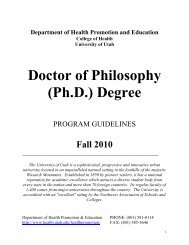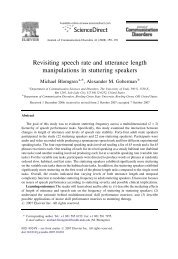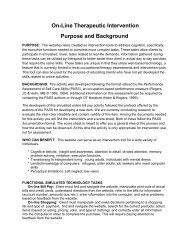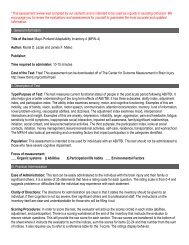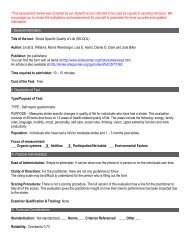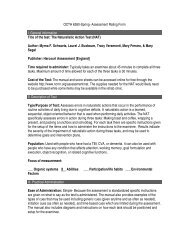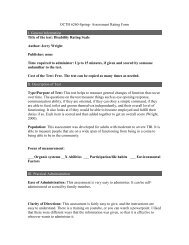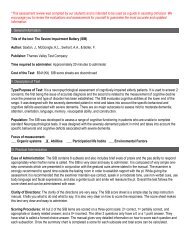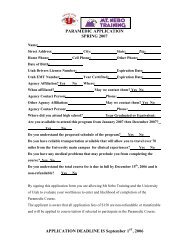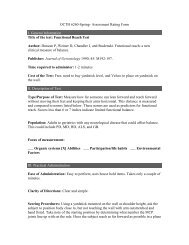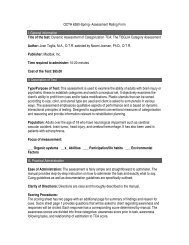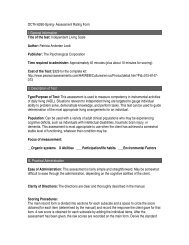Tinetti
Tinetti
Tinetti
- No tags were found...
You also want an ePaper? Increase the reach of your titles
YUMPU automatically turns print PDFs into web optimized ePapers that Google loves.
*This assessment review was compiled by our students and is intended to be used as a guide inassisting clinicians. We encourage you to review the evaluations and assessments for yourself toguarantee the most accurate and updated information.I. General InformationTitle of the test: <strong>Tinetti</strong> Balance Test of the Performance-Oriented Assessment of MobilityProblems (<strong>Tinetti</strong>)Author: Mary <strong>Tinetti</strong>, MD, 1986Publisher: Stall GeriatricsTime required to administer: 10 minutesCost of the Test: Free – can be found online at the following linkhttp://geriatrics.uthscsa.edu/tools/TINETTI.pdfII. Description of TestType/Purpose of Test: The purpose of the test is to measure performance of balance and gaitduring maneuvers used during normal daily activities. The balance portion consists of 9maneuvers which are graded on an ordinal scale as normal, adaptive, or abnormal. The gaitportion measures seven gait characteristics as normal or abnormal. The assessment is designedto determine a person’s risk for falls within the next year.Population: Adults who are over 65 years of age and for persons with identifiable pathology,Focus of measurement: Standing and sitting balance; Balance during sit to stand and stand to sit;balance during turning 360 degrees; Balance when nudged on sternum; Balance when eyes areclosed; Gait execution; And walking stance___ Organic systems _X_ Abilities ___ Participation/life habits ___ EnvironmentalFactorsIII. Practical AdministrationEase of Administration: The test is very easy to administer. The scoring procedures are listed onthe scoring sheet with definitions of how to score each item next to each number score.Clarity of Directions: The directions are relatively clear; I have included the directions in thissection due to the shortness of the directions. The test is fairly straightforward and does notrequire excessive instructions.Instructions for the balance component: Subject is seated in a hard, armless chair, maneuvers areperformed.Instructions for gait section: Subject stands with examiner, walks down hallway or across the room,first at “usual” pace, then back at “rapid, but safe” pace (using usual walking aids).
Scoring Procedures: Each item on the <strong>Tinetti</strong> Assessment Tool is scored on either a three pointordinal scale with a range of 0 to 2 or a two point ordinal scale with a range of 0 to 1. A score of 0indicates the most impairment, while the higher numbers 1 and 2 indicate less impairment.Detailed explanations of how to score each item based on the client’s performance is listed next tothe item being scored. Once each item is scored the individual item scores are combined to formthree scores; a gait assessment score, a balance assessment score, and a gait and balance score.Interpretation: The maximum score for the gait component is 12 points. The maximum score forthe balance component is 16 points. The maximum total score is 28 points. Patients who scorebelow 19 are at a high risk for falls. Patients who score in the range of 19-24 have a moderate riskfor falls. Patients who score between 24-28 have a minimal risk for falling.Examiner Qualification & Training: There is no official qualification and training, you just have tobe trained on the test procedures and the scoring procedures.IV. Technical ConsiderationsStandardization: __x__ Norms ______ Criterion Referenced____ Other ___________Reliability: Inter-rater reliability is .85 ± .10Validity: Content validity; concurrent validity; construct validity; criterion validity, predictive validityManual: ____ Excellent __x__ Adequate ____ PoorThere is not a manual for this assessment, but the handouts that describe the assessmentand the research on the <strong>Tinetti</strong> is adequate.What is (are) the setting/s that you would anticipate using this assessment?Nursing homes, home health, transitional rehabilitation, inpatient rehabilitation, SNFsSummary of strengths and weaknesses:Weakness: The weaknesses of the test include the following:- The test may not be sensitive to changes in balance as reported by Whitney, Poole, andCass in their research article “A Review of Balance Instruments for Older Adults” whichwas published in The American Journal of Occupational Therapy.- There is not a manual with clear information on how the test was formulated and thereliability and validity of the assessment.Strength: The strengths of this assessment include the following:- Assesses many different aspects of balance- Simple and quick to administer- No certified qualification and training is required to administer the assessment- The assessment can be found online for free- Scoring is uncomplicated and easy to interpret- The test has high inter rater reliability- The test has a variety of forms of validity


